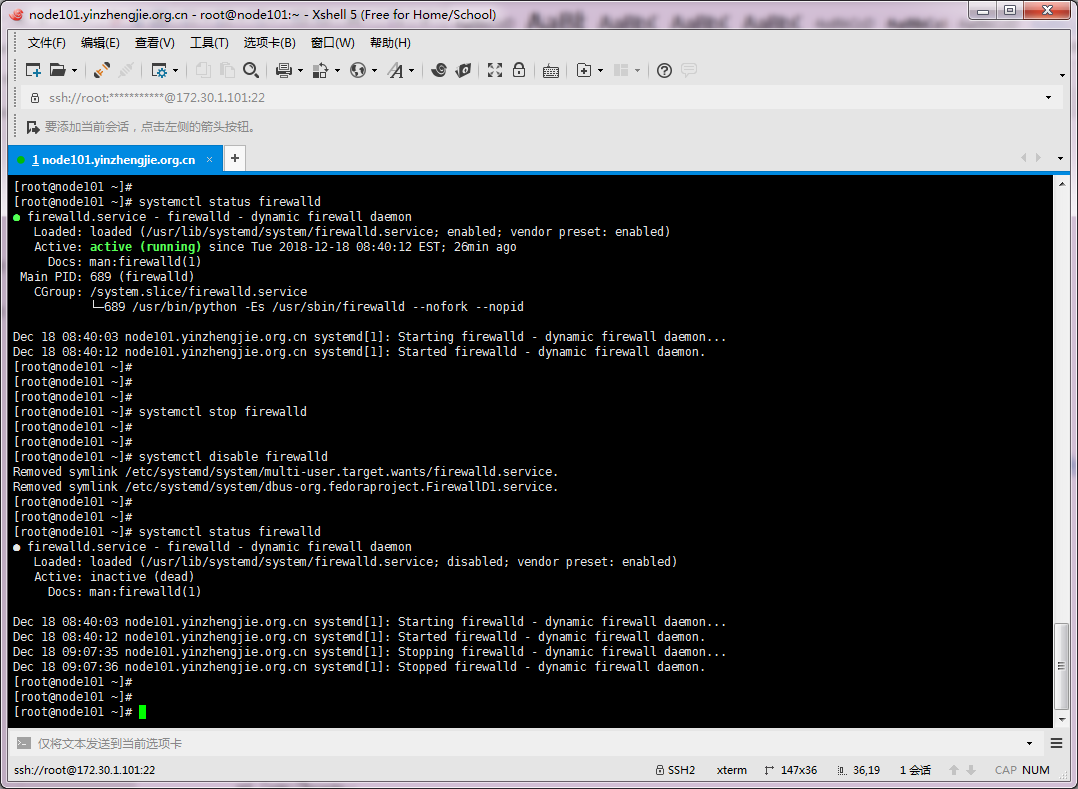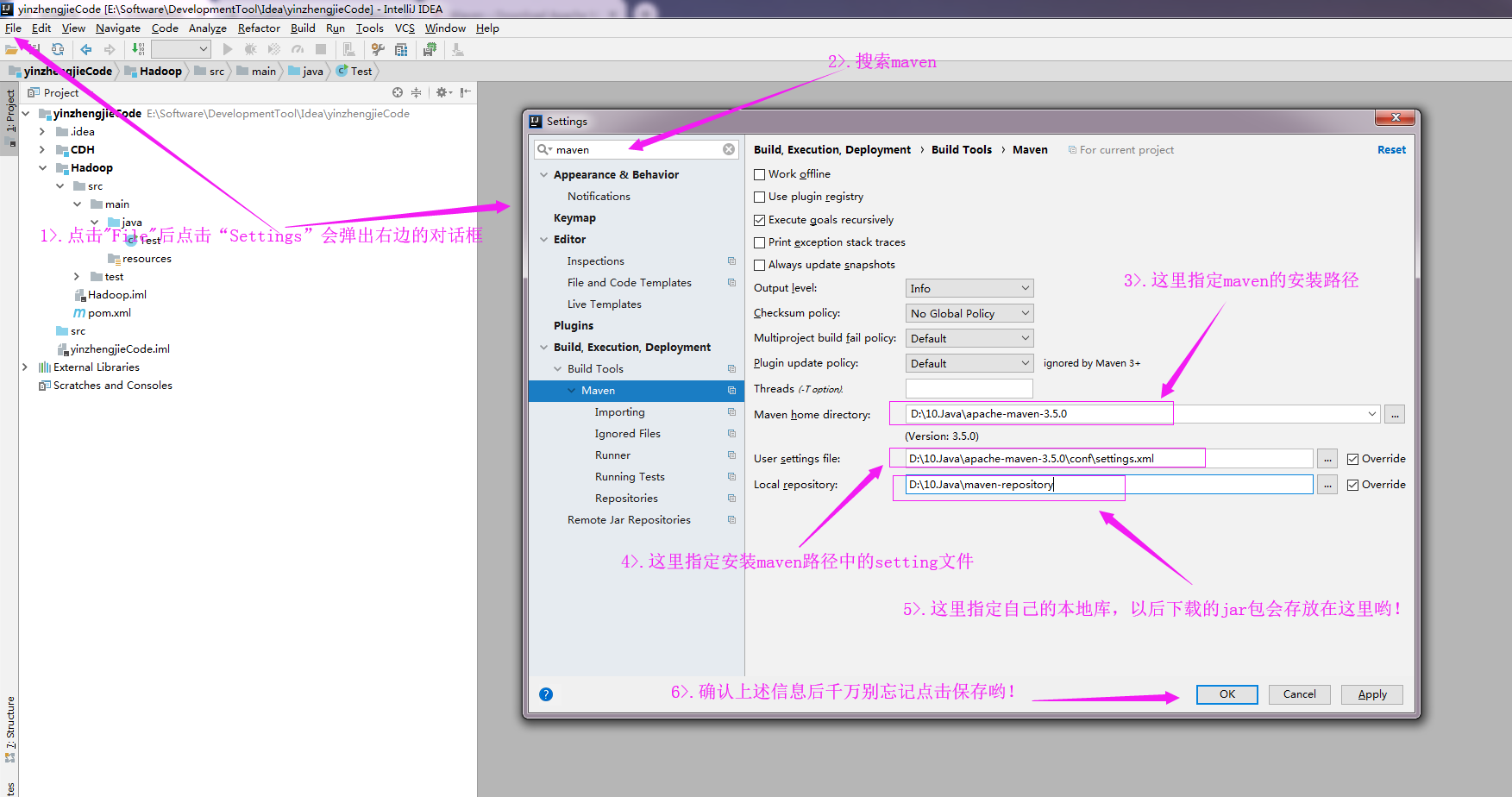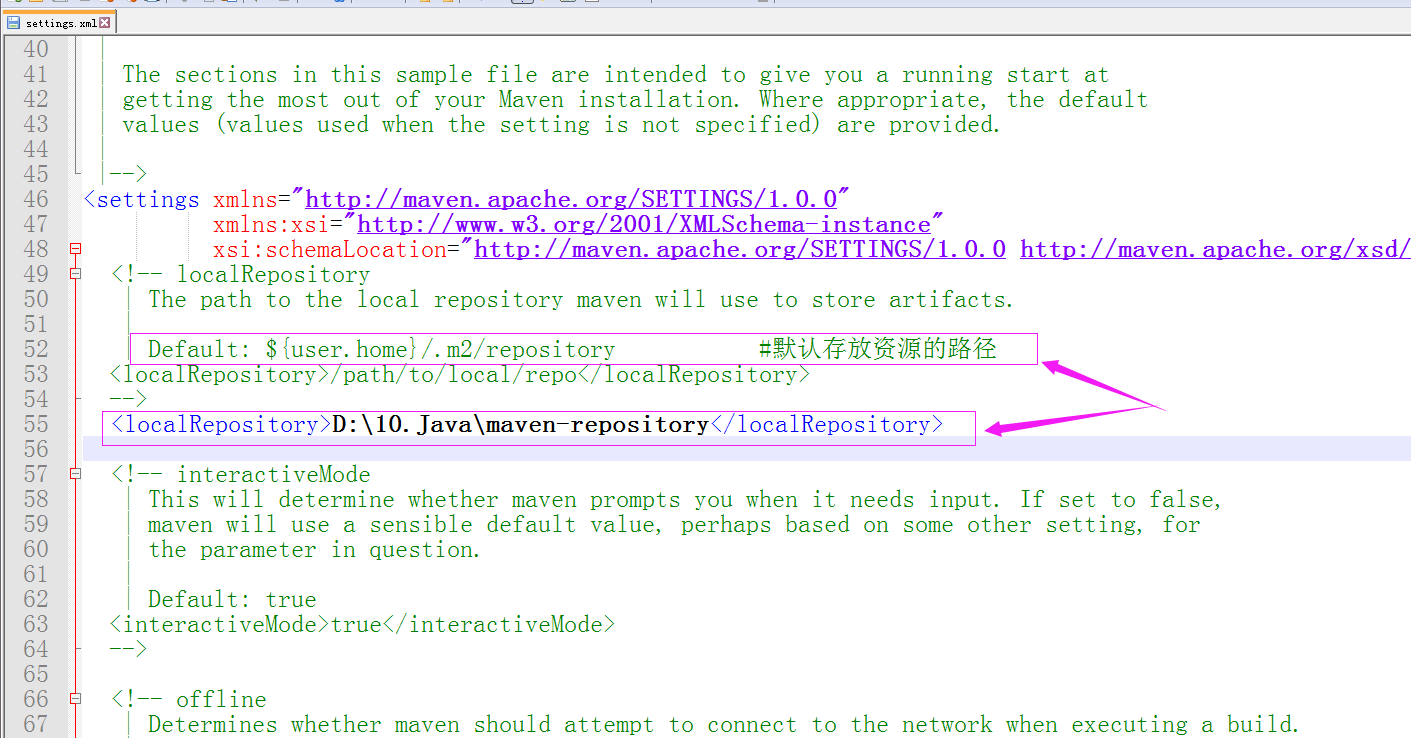Maven 本地资源库配置
作者:尹正杰
版权声明:原创作品,谢绝转载!否则将追究法律责任。
一.操作系统环境
1>.查看操作系统环境(总共3台虚拟机)

2>.关闭防火墙并禁用开机自启动(“node102.yinzhengjie.org.cn”和“node103.yinzhengjie.org.cn”两个节点需要重复此操作)

[root@node101 ~]# systemctl status firewalld ● firewalld.service - firewalld - dynamic firewall daemon Loaded: loaded (/usr/lib/systemd/system/firewalld.service; enabled; vendor preset: enabled) Active: active (running) since Tue 2018-12-18 08:40:12 EST; 26min ago Docs: man:firewalld(1) Main PID: 689 (firewalld) CGroup: /system.slice/firewalld.service └─689 /usr/bin/python -Es /usr/sbin/firewalld --nofork --nopid Dec 18 08:40:03 node101.yinzhengjie.org.cn systemd[1]: Starting firewalld - dynamic firewall daemon... Dec 18 08:40:12 node101.yinzhengjie.org.cn systemd[1]: Started firewalld - dynamic firewall daemon. [root@node101 ~]# [root@node101 ~]# [root@node101 ~]# [root@node101 ~]# systemctl stop firewalld [root@node101 ~]# [root@node101 ~]# [root@node101 ~]# systemctl disable firewalld Removed symlink /etc/systemd/system/multi-user.target.wants/firewalld.service. Removed symlink /etc/systemd/system/dbus-org.fedoraproject.FirewallD1.service. [root@node101 ~]# [root@node101 ~]# [root@node101 ~]# systemctl status firewalld ● firewalld.service - firewalld - dynamic firewall daemon Loaded: loaded (/usr/lib/systemd/system/firewalld.service; disabled; vendor preset: enabled) Active: inactive (dead) Docs: man:firewalld(1) Dec 18 08:40:03 node101.yinzhengjie.org.cn systemd[1]: Starting firewalld - dynamic firewall daemon... Dec 18 08:40:12 node101.yinzhengjie.org.cn systemd[1]: Started firewalld - dynamic firewall daemon. Dec 18 09:07:35 node101.yinzhengjie.org.cn systemd[1]: Stopping firewalld - dynamic firewall daemon... Dec 18 09:07:36 node101.yinzhengjie.org.cn systemd[1]: Stopped firewalld - dynamic firewall daemon. [root@node101 ~]#

3>.关闭selinux并禁用其开机自启动(“node102.yinzhengjie.org.cn”和“node103.yinzhengjie.org.cn”两个节点需要重复此操作)

[root@node101 ~]# getenforce Enforcing [root@node101 ~]# [root@node101 ~]# setenforce 0 [root@node101 ~]# [root@node101 ~]# getenforce Permissive [root@node101 ~]# [root@node101 ~]# cat /etc/selinux/config | grep SELINUX= | grep -v ^# SELINUX=enforcing [root@node101 ~]# [root@node101 ~]# sed -i 's#SELINUX=enforcing#SELINUX=disabled#' /etc/selinux/config [root@node101 ~]# [root@node101 ~]# cat /etc/selinux/config | grep SELINUX= | grep -v ^# SELINUX=disabled [root@node101 ~]#

4>.编写集群管理脚本

[root@node101 ~]# ssh-keygen -t rsa -P '' -f ~/.ssh/id_rsa Generating public/private rsa key pair. Created directory '/root/.ssh'. Your identification has been saved in /root/.ssh/id_rsa. Your public key has been saved in /root/.ssh/id_rsa.pub. The key fingerprint is: SHA256:LzQFxaeYjEKQVSTx7RwZQaWkCYC8ry6dVkl4RzHJ6os root@node101.yinzhengjie.org.cn The key's randomart image is: +---[RSA 2048]----+ |..o====+*=o | |... .++* =. . | | .o o+o=o.o | | .. = oo+o. | | .+ + S | | .+ . o | | ..+ . . . | |..E . . | |oo | +----[SHA256]-----+ [root@node101 ~]#

[root@node101 ~]# ssh-copy-id root@node101.yinzhengjie.org.cn /usr/bin/ssh-copy-id: INFO: Source of key(s) to be installed: "/root/.ssh/id_rsa.pub" The authenticity of host 'node101.yinzhengjie.org.cn (172.30.1.101)' can't be established. ECDSA key fingerprint is SHA256:aGk7Wv77uRVAElcihCH0Zu0sAPp6qEs2sSA1Zsj3o7g. ECDSA key fingerprint is MD5:2b:74:b8:ad:f8:92:78:04:38:90:f1:28:e7:70:68:fb. Are you sure you want to continue connecting (yes/no)? yes /usr/bin/ssh-copy-id: INFO: attempting to log in with the new key(s), to filter out any that are already installed /usr/bin/ssh-copy-id: INFO: 1 key(s) remain to be installed -- if you are prompted now it is to install the new keys root@node101.yinzhengjie.org.cn's password: Number of key(s) added: 1 Now try logging into the machine, with: "ssh 'root@node101.yinzhengjie.org.cn'" and check to make sure that only the key(s) you wanted were added. [root@node101 ~]# [root@node101 ~]# ssh node101.yinzhengjie.org.cn Last login: Tue Dec 18 08:57:22 2018 from 172.30.1.1 [root@node101 ~]# who root pts/0 2018-12-18 08:57 (172.30.1.1) root pts/1 2018-12-18 09:13 (node101.yinzhengjie.org.cn) [root@node101 ~]# exit logout Connection to node101.yinzhengjie.org.cn closed. [root@node101 ~]#

[root@node101 ~]# ssh-copy-id root@node102.yinzhengjie.org.cn /usr/bin/ssh-copy-id: INFO: Source of key(s) to be installed: "/root/.ssh/id_rsa.pub" The authenticity of host 'node102.yinzhengjie.org.cn (172.30.1.102)' can't be established. ECDSA key fingerprint is SHA256:aGk7Wv77uRVAElcihCH0Zu0sAPp6qEs2sSA1Zsj3o7g. ECDSA key fingerprint is MD5:2b:74:b8:ad:f8:92:78:04:38:90:f1:28:e7:70:68:fb. Are you sure you want to continue connecting (yes/no)? yes /usr/bin/ssh-copy-id: INFO: attempting to log in with the new key(s), to filter out any that are already installed /usr/bin/ssh-copy-id: INFO: 1 key(s) remain to be installed -- if you are prompted now it is to install the new keys root@node102.yinzhengjie.org.cn's password: Number of key(s) added: 1 Now try logging into the machine, with: "ssh 'root@node102.yinzhengjie.org.cn'" and check to make sure that only the key(s) you wanted were added. [root@node101 ~]# [root@node101 ~]# ssh node102.yinzhengjie.org.cn Last login: Tue Dec 18 08:36:15 2018 [root@node102 ~]# [root@node102 ~]# who root pts/0 2018-12-18 09:14 (172.30.1.101) [root@node102 ~]# [root@node102 ~]# exit logout Connection to node102.yinzhengjie.org.cn closed. [root@node101 ~]#

[root@node101 ~]# ssh-copy-id root@node103.yinzhengjie.org.cn /usr/bin/ssh-copy-id: INFO: Source of key(s) to be installed: "/root/.ssh/id_rsa.pub" The authenticity of host 'node103.yinzhengjie.org.cn (172.30.1.103)' can't be established. ECDSA key fingerprint is SHA256:aGk7Wv77uRVAElcihCH0Zu0sAPp6qEs2sSA1Zsj3o7g. ECDSA key fingerprint is MD5:2b:74:b8:ad:f8:92:78:04:38:90:f1:28:e7:70:68:fb. Are you sure you want to continue connecting (yes/no)? yes /usr/bin/ssh-copy-id: INFO: attempting to log in with the new key(s), to filter out any that are already installed /usr/bin/ssh-copy-id: INFO: 1 key(s) remain to be installed -- if you are prompted now it is to install the new keys root@node103.yinzhengjie.org.cn's password: Number of key(s) added: 1 Now try logging into the machine, with: "ssh 'root@node103.yinzhengjie.org.cn'" and check to make sure that only the key(s) you wanted were added. [root@node101 ~]# [root@node101 ~]# ssh node103.yinzhengjie.org.cn Last login: Sat Dec 15 16:54:09 2018 [root@node103 ~]# [root@node103 ~]# who root pts/0 2018-12-18 09:15 (172.30.1.101) [root@node103 ~]# [root@node103 ~]# exit logout Connection to node103.yinzhengjie.org.cn closed. [root@node101 ~]#

[root@node101 ~]# vi /usr/local/bin/xcall.sh #我们创建该脚本时,直接就把它放在默认的“PATH”环境变量中。因此编辑好后只要有执行权限就可以在任意路径调用它啦! [root@node101 ~]# [root@node101 ~]# [root@node101 ~]# cat /usr/local/bin/xcall.sh #!/bin/bash #@author :yinzhengjie #blog:http://www.cnblogs.com/yinzhengjie #EMAIL:y1053419035@qq.com #判断用户是否传参 if [ $# -lt 1 ];then echo "请输入参数" exit fi #获取用户输入的命令 cmd=$@ for (( i=101;i<=103;i++ )) do #使终端变绿色 tput setaf 2 echo ============= node${i}.yinzhengjie.org.cn : $cmd ============ #使终端变回原来的颜色,即白灰色 tput setaf 7 #远程执行命令 ssh node${i}.yinzhengjie.org.cn $cmd #判断命令是否执行成功 if [ $? == 0 ];then echo "命令执行成功" fi done [root@node101 ~]# [root@node101 ~]# [root@node101 ~]# chmod +x /usr/local/bin/xcall.sh #别忘记添加执行权限哟! [root@node101 ~]# [root@node101 ~]# xcall.sh cat /etc/redhat-release #我们在这里可以测试一些咱们的脚本是否好使~ ============= node101.yinzhengjie.org.cn : cat /etc/redhat-release ============ CentOS Linux release 7.2.1511 (Core) 命令执行成功 ============= node102.yinzhengjie.org.cn : cat /etc/redhat-release ============ CentOS Linux release 7.2.1511 (Core) 命令执行成功 ============= node103.yinzhengjie.org.cn : cat /etc/redhat-release ============ CentOS Linux release 7.2.1511 (Core) 命令执行成功 [root@node101 ~]# [root@node101 ~]#

[root@node101 ~]# xcall.sh "yum -y install rsync" ============= node101.yinzhengjie.org.cn : yum -y install rsync ============ Loaded plugins: fastestmirror Loading mirror speeds from cached hostfile * base: mirrors.huaweicloud.com * extras: mirrors.huaweicloud.com * updates: mirrors.163.com Resolving Dependencies --> Running transaction check ---> Package rsync.x86_64 0:3.1.2-4.el7 will be installed --> Finished Dependency Resolution Dependencies Resolved ================================================================================ Package Arch Version Repository Size ================================================================================ Installing: rsync x86_64 3.1.2-4.el7 base 403 k Transaction Summary ================================================================================ Install 1 Package Total download size: 403 k Installed size: 815 k Downloading packages: Running transaction check Running transaction test Transaction test succeeded Running transaction Installing : rsync-3.1.2-4.el7.x86_64 1/1 Verifying : rsync-3.1.2-4.el7.x86_64 1/1 Installed: rsync.x86_64 0:3.1.2-4.el7 Complete! 命令执行成功 ============= node102.yinzhengjie.org.cn : yum -y install rsync ============ Loaded plugins: fastestmirror Repodata is over 2 weeks old. Install yum-cron? Or run: yum makecache fast http://mirrors.njupt.edu.cn/centos/7.6.1810/os/x86_64/repodata/bc140c8149fc43a5248fccff0daeef38182e49f6fe75d9b46db1206dc25a6c1c-c7-x86_64-comps.xml.gz: [Errno 12] Timeout on http://10.10.254.10/cache/5/02/mirrors.njupt.edu.cn/033b2636ff3cf3103169fa739764fdd7/bc140c8149fc43a5248fccff0daeef38182e49f6fe75d9b46db1206dc25a6c1c-c7-x86_64-comps.xml.gz: (28, 'Connection timed out after 30682 milliseconds') Trying other mirror. http://mirrors.njupt.edu.cn/centos/7.6.1810/updates/x86_64/repodata/8e273c72093a2cfc3f3b2baccfb2b01f7f4bcdc1bb72d53e38074068a756f1c6-primary.sqlite.bz2: [Errno 12] Timeout on http://10.10.254.10/cache/4/02/mirrors.njupt.edu.cn/c35de49cce30395fb97f6c41a56fbad5/8e273c72093a2cfc3f3b2baccfb2b01f7f4bcdc1bb72d53e38074068a756f1c6-primary.sqlite.bz2: (28, 'Connection timed out after 30672 milliseconds') Trying other mirror. Determining fastest mirrors * base: mirrors.huaweicloud.com * extras: mirrors.huaweicloud.com * updates: mirrors.neusoft.edu.cn Resolving Dependencies --> Running transaction check ---> Package rsync.x86_64 0:3.1.2-4.el7 will be installed --> Finished Dependency Resolution Dependencies Resolved ================================================================================ Package Arch Version Repository Size ================================================================================ Installing: rsync x86_64 3.1.2-4.el7 base 403 k Transaction Summary ================================================================================ Install 1 Package Total download size: 403 k Installed size: 815 k Downloading packages: Running transaction check Running transaction test Transaction test succeeded Running transaction Installing : rsync-3.1.2-4.el7.x86_64 1/1 Verifying : rsync-3.1.2-4.el7.x86_64 1/1 Installed: rsync.x86_64 0:3.1.2-4.el7 Complete! 命令执行成功 ============= node103.yinzhengjie.org.cn : yum -y install rsync ============ Loaded plugins: fastestmirror Repodata is over 2 weeks old. Install yum-cron? Or run: yum makecache fast http://mirrors.njupt.edu.cn/centos/7.6.1810/os/x86_64/repodata/6614b3605d961a4aaec45d74ac4e5e713e517debb3ee454a1c91097955780697-primary.sqlite.bz2: [Errno 12] Timeout on http://10.10.254.10/cache/5/02/mirrors.njupt.edu.cn/fa6cd86bdbaedbbfedfbfa6d45952cd2/6614b3605d961a4aaec45d74ac4e5e713e517debb3ee454a1c91097955780697-primary.sqlite.bz2: (28, 'Connection timed out after 30867 milliseconds') Trying other mirror. Determining fastest mirrors * base: mirrors.huaweicloud.com * extras: mirrors.huaweicloud.com * updates: mirrors.cn99.com Resolving Dependencies --> Running transaction check ---> Package rsync.x86_64 0:3.1.2-4.el7 will be installed --> Finished Dependency Resolution Dependencies Resolved ================================================================================ Package Arch Version Repository Size ================================================================================ Installing: rsync x86_64 3.1.2-4.el7 base 403 k Transaction Summary ================================================================================ Install 1 Package Total download size: 403 k Installed size: 815 k Downloading packages: Running transaction check Running transaction test Transaction test succeeded Running transaction Installing : rsync-3.1.2-4.el7.x86_64 1/1 Verifying : rsync-3.1.2-4.el7.x86_64 1/1 Installed: rsync.x86_64 0:3.1.2-4.el7 Complete! 命令执行成功 [root@node101 ~]#

[root@node101 ~]# vi /usr/local/bin/xrsync.sh #编写同步脚本,注意:我们在编写脚本时,就把脚本放在Linux自带的“PATH”环境变量中。 [root@node101 ~]# [root@node101 ~]# cat /usr/local/bin/xrsync.sh #!/bin/bash #@author :yinzhengjie #blog:http://www.cnblogs.com/yinzhengjie #EMAIL:y1053419035@qq.com #判断用户是否传参 if [ $# -lt 1 ];then echo "请输入参数"; exit fi #获取文件路径 file=$@ #获取子路径 filename=`basename $file` #获取父路径 dirpath=`dirname $file` #获取完整路径 cd $dirpath fullpath=`pwd -P` #同步文件到DataNode for (( i=102;i<=103;i++ )) do #使终端变绿色 tput setaf 2 echo =========== node${i}.yinzhengjie.org.cn : $file =========== #使终端变回原来的颜色,即白灰色 tput setaf 7 #远程执行命令 rsync -lr $filename `whoami`@node${i}.yinzhengjie.org.cn:$fullpath #判断命令是否执行成功 if [ $? == 0 ];then echo "命令执行成功" fi done [root@node101 ~]# [root@node101 ~]# [root@node101 ~]# chmod +x /usr/local/bin/xrsync.sh #别忘记添加执行权限哟! [root@node101 ~]#

[root@node101 ~]# xrsync.sh /etc/hosts =========== node102.yinzhengjie.org.cn : /etc/hosts =========== 命令执行成功 =========== node103.yinzhengjie.org.cn : /etc/hosts =========== 命令执行成功 [root@node101 ~]# [root@node101 ~]# xcall.sh cat /etc/hosts ============= node101.yinzhengjie.org.cn : cat /etc/hosts ============ 127.0.0.1 localhost localhost.localdomain localhost4 localhost4.localdomain4 ::1 localhost localhost.localdomain localhost6 localhost6.localdomain6 172.30.1.101 node101.yinzhengjie.org.cn 172.30.1.102 node102.yinzhengjie.org.cn 172.30.1.103 node103.yinzhengjie.org.cn 命令执行成功 ============= node102.yinzhengjie.org.cn : cat /etc/hosts ============ 127.0.0.1 localhost localhost.localdomain localhost4 localhost4.localdomain4 ::1 localhost localhost.localdomain localhost6 localhost6.localdomain6 172.30.1.101 node101.yinzhengjie.org.cn 172.30.1.102 node102.yinzhengjie.org.cn 172.30.1.103 node103.yinzhengjie.org.cn 命令执行成功 ============= node103.yinzhengjie.org.cn : cat /etc/hosts ============ 127.0.0.1 localhost localhost.localdomain localhost4 localhost4.localdomain4 ::1 localhost localhost.localdomain localhost6 localhost6.localdomain6 172.30.1.101 node101.yinzhengjie.org.cn 172.30.1.102 node102.yinzhengjie.org.cn 172.30.1.103 node103.yinzhengjie.org.cn 命令执行成功 [root@node101 ~]#
二.安装jdk并配置相应的环境变量
1>.JDK下载地址
Oracle官网JDK下载地址:https://www.oracle.com/technetwork/java/javase/downloads/jdk8-downloads-2133151.html。
2>.在"node101.yinzhengjie.org.cn"配置jdk的环境变量

[root@node101 ~]# yum -y install lrzsz Loaded plugins: fastestmirror Loading mirror speeds from cached hostfile * base: mirrors.aliyun.com * extras: mirrors.nju.edu.cn * updates: mirrors.nju.edu.cn Resolving Dependencies --> Running transaction check ---> Package lrzsz.x86_64 0:0.12.20-36.el7 will be installed --> Finished Dependency Resolution Dependencies Resolved ============================================================================================================================================= Package Arch Version Repository Size ============================================================================================================================================= Installing: lrzsz x86_64 0.12.20-36.el7 base 78 k Transaction Summary ============================================================================================================================================= Install 1 Package Total download size: 78 k Installed size: 181 k Downloading packages: lrzsz-0.12.20-36.el7.x86_64.rpm | 78 kB 00:00:00 Running transaction check Running transaction test Transaction test succeeded Running transaction Installing : lrzsz-0.12.20-36.el7.x86_64 1/1 Verifying : lrzsz-0.12.20-36.el7.x86_64 1/1 Installed: lrzsz.x86_64 0:0.12.20-36.el7 Complete! [root@node101 ~]#
[root@node101 ~]# mkdir -pv /yinzhengjie/soft/ mkdir: created directory ‘/yinzhengjie’ mkdir: created directory ‘/yinzhengjie/soft/’ [root@node101 ~]# [root@node101 ~]# ll total 187260 -rw-r--r--. 1 root root 191753373 Dec 18 09:25 jdk-8u191-linux-x64.tar.gz [root@node101 ~]# [root@node101 ~]# tar -zxf jdk-8u191-linux-x64.tar.gz -C /yinzhengjie/soft/ [root@node101 ~]# [root@node101 ~]# ln -s /yinzhengjie/soft/jdk1.8.0_191/ /yinzhengjie/soft/jdk [root@node101 ~]# [root@node101 ~]# tail -3 /etc/profile #Add JDK Path by yinzhengjie JAVA_HOME=/yinzhengjie/soft/jdk PATH=$PATH:$JAVA_HOME/bin [root@node101 ~]# [root@node101 ~]# source /etc/profile [root@node101 ~]# [root@node101 ~]# java -version java version "1.8.0_191" Java(TM) SE Runtime Environment (build 1.8.0_191-b12) Java HotSpot(TM) 64-Bit Server VM (build 25.191-b12, mixed mode) [root@node101 ~]#
3>.分发"node101.yinzhengjie.org.cn"的配置到“node102.yinzhengjie.org.cn”和“node103.yinzhengjie.org.cn”主机上
[root@node101 ~]# xrsync.sh /etc/profile =========== node102.yinzhengjie.org.cn : /etc/profile =========== 命令执行成功 =========== node103.yinzhengjie.org.cn : /etc/profile =========== 命令执行成功 [root@node101 ~]# [root@node101 ~]# [root@node101 ~]# xrsync.sh /yinzhengjie/ =========== node102.yinzhengjie.org.cn : /yinzhengjie/ =========== 命令执行成功 =========== node103.yinzhengjie.org.cn : /yinzhengjie/ =========== 命令执行成功 [root@node101 ~]# [root@node101 ~]# [root@node101 ~]# xcall.sh ln -s /yinzhengjie/soft/jdk/bin/jps /usr/local/bin/ ============= node101.yinzhengjie.org.cn : ln -s /yinzhengjie/soft/jdk/bin/jps /usr/local/bin/ ============ 命令执行成功 ============= node102.yinzhengjie.org.cn : ln -s /yinzhengjie/soft/jdk/bin/jps /usr/local/bin/ ============ 命令执行成功 ============= node103.yinzhengjie.org.cn : ln -s /yinzhengjie/soft/jdk/bin/jps /usr/local/bin/ ============ 命令执行成功 [root@node101 ~]# [root@node101 ~]# xcall.sh jps ============= node101.yinzhengjie.org.cn : jps ============ 9140 Jps 命令执行成功 ============= node102.yinzhengjie.org.cn : jps ============ 8745 Jps 命令执行成功 ============= node103.yinzhengjie.org.cn : jps ============ 8737 Jps 命令执行成功 [root@node101 ~]#
三.maven的安装配置
1>.安装maven
maven的官方下载地址:http://maven.apache.org/download.cgi。
2>.Eclipse中maven配置
详情请参考:Eclipse第三方安装包管理工具之Maven
3>.Idea中maven配置
其实配置方法和maven的方式基本雷同。

四.maven本地资源库配置
1>.maven的Setting.xml文件说明

如下是settings.xml的配置,重点讲解几个地方,因为接下来我们要配置安装自己的maven私有库 <?xml version="1.0" encoding="UTF-8"?> <settings xmlns="http://maven.apache.org/POM/4.0.0" xmlns:xsi="http://www.w3.org/2001/XMLSchema-instance" xsi:schemaLocation="http://maven.apache.org/POM/4.0.0 http://maven.apache.org/xsd/settings-1.0.0.xsd"> <!--本地仓库。该值表示构建系统本地仓库的路径。其默认值为${user.home}/.m2/repository。 --> <localRepository>${user.home}/.m2/repository </localRepository> <!--Maven是否需要和用户交互以获得输入。如果Maven需要和用户交互以获得输入,则设置成true,反之则应为false。默认为true。 --> <interactiveMode>true</interactiveMode> <!--Maven是否需要使用plugin-registry.xml文件来管理插件版本。 --> <!--如果设置为true,则在{user.home}/.m2下需要有一个plugin-registry.xml来对plugin的版本进行管理 --> <!--默认为false。 --> <usePluginRegistry>false</usePluginRegistry> <!--表示Maven是否需要在离线模式下运行。如果构建系统需要在离线模式下运行,则为true,默认为false。 --> <!--当由于网络设置原因或者安全因素,构建服务器不能连接远程仓库的时候,该配置就十分有用。 --> <offline>false</offline> <!--当插件的组织Id(groupId)没有显式提供时,供搜寻插件组织Id(groupId)的列表。 --> <!--该元素包含一个pluginGroup元素列表,每个子元素包含了一个组织Id(groupId)。 --> <!--当我们使用某个插件,并且没有在命令行为其提供组织Id(groupId)的时候,Maven就会使用该列表。 --> <!--默认情况下该列表包含了org.apache.maven.plugins。 --> <pluginGroups> <!--plugin的组织Id(groupId) --> <pluginGroup>org.codehaus.mojo</pluginGroup> </pluginGroups> <!--用来配置不同的代理,多代理profiles可以应对笔记本或移动设备的工作环境:通过简单的设置profile id就可以很容易的更换整个代理配置。 --> <proxies> <!--代理元素包含配置代理时需要的信息 --> <proxy> <!--代理的唯一定义符,用来区分不同的代理元素。 --> <id>myproxy</id> <!--该代理是否是激活的那个。true则激活代理。当我们声明了一组代理,而某个时候只需要激活一个代理的时候,该元素就可以派上用处。 --> <active>true</active> <!--代理的协议。 协议://主机名:端口,分隔成离散的元素以方便配置。 --> <protocol>http://…</protocol> <!--代理的主机名。协议://主机名:端口,分隔成离散的元素以方便配置。 --> <host>proxy.somewhere.com</host> <!--代理的端口。协议://主机名:端口,分隔成离散的元素以方便配置。 --> <port>8080</port> <!--代理的用户名,用户名和密码表示代理服务器认证的登录名和密码。 --> <username>proxyuser</username> <!--代理的密码,用户名和密码表示代理服务器认证的登录名和密码。 --> <password>somepassword</password> <!--不该被代理的主机名列表。该列表的分隔符由代理服务器指定;例子中使用了竖线分隔符,使用逗号分隔也很常见。 --> <nonProxyHosts>*.google.com|ibiblio.org</nonProxyHosts> </proxy> </proxies> <!--配置服务端的一些设置。一些设置如安全证书不应该和pom.xml一起分发。这种类型的信息应该存在于构建服务器上的settings.xml文件中。 --> <servers> <!--服务器元素包含配置服务器时需要的信息 --> <server> <!--这是server的id(注意不是用户登陆的id),该id与distributionManagement中repository元素的id相匹配。 --> <id>server001</id> <!--鉴权用户名。鉴权用户名和鉴权密码表示服务器认证所需要的登录名和密码。 --> <username>my_login</username> <!--鉴权密码 。鉴权用户名和鉴权密码表示服务器认证所需要的登录名和密码。 --> <password>my_password</password> <!--鉴权时使用的私钥位置。和前两个元素类似,私钥位置和私钥密码指定了一个私钥的路径(默认是/home/hudson/.ssh/id_dsa)以及如果需要的话,一个密钥 --> <!--将来passphrase和password元素可能会被提取到外部,但目前它们必须在settings.xml文件以纯文本的形式声明。 --> <privateKey>${usr.home}/.ssh/id_dsa</privateKey> <!--鉴权时使用的私钥密码。 --> <passphrase>some_passphrase</passphrase> <!--文件被创建时的权限。如果在部署的时候会创建一个仓库文件或者目录,这时候就可以使用权限(permission)。--> <!--这两个元素合法的值是一个三位数字,其对应了unix文件系统的权限,如664,或者775。 --> <filePermissions>664</filePermissions> <!--目录被创建时的权限。 --> <directoryPermissions>775</directoryPermissions> <!--传输层额外的配置项 --> <configuration></configuration> </server> </servers> <!--为仓库列表配置的下载镜像列表。 --> <mirrors> <!--给定仓库的下载镜像。 --> <mirror> <!--该镜像的唯一标识符。id用来区分不同的mirror元素。 --> <id>planetmirror.com</id> <!--镜像名称 --> <name>PlanetMirror Australia</name> <!--该镜像的URL。构建系统会优先考虑使用该URL,而非使用默认的服务器URL。 --> <url>http://downloads.planetmirror.com/pub/maven2</url> <!--被镜像的服务器的id。例如,如果我们要设置了一个Maven中央仓库(http://repo1.maven.org/maven2)的镜像,--> <!--就需要将该元素设置成central。这必须和中央仓库的id central完全一致。 --> <mirrorOf>central</mirrorOf> </mirror> </mirrors> <!--根据环境参数来调整构建配置的列表。settings.xml中的profile元素是pom.xml中profile元素的裁剪版本。--> <!--它包含了id,activation, repositories, pluginRepositories和 properties元素。--> <!--这里的profile元素只包含这五个子元素是因为这里只关心构建系统这个整体(这正是settings.xml文件的角色定位),而非单独的项目对象模型设置。--> <!--如果一个settings中的profile被激活,它的值会覆盖任何其它定义在POM中或者profile.xml中的带有相同id的profile。 --> <profiles> <!--根据环境参数来调整的构件的配置 --> <profile> <!--该配置的唯一标识符。 --> <id>test</id> <!--自动触发profile的条件逻辑。Activation是profile的开启钥匙。--> <!--如POM中的profile一样,profile的力量来自于它能够在某些特定的环境中自动使用某些特定的值;这些环境通过activation元素指定。--> <!--activation元素并不是激活profile的唯一方式。settings.xml文件中的activeProfile元素可以包含profile的id。--> <!--profile也可以通过在命令行,使用-P标记和逗号分隔的列表来显式的激活(如,-P test)。 --> <activation> <!--profile默认是否激活的标识 --> <activeByDefault>false</activeByDefault> <!--activation有一个内建的java版本检测,如果检测到jdk版本与期待的一样,profile被激活。 --> <jdk>1.7</jdk> <!--当匹配的操作系统属性被检测到,profile被激活。os元素可以定义一些操作系统相关的属性。 --> <os> <!--激活profile的操作系统的名字 --> <name>Windows XP</name> <!--激活profile的操作系统所属家族(如 'windows') --> <family>Windows</family> <!--激活profile的操作系统体系结构 --> <arch>x86</arch> <!--激活profile的操作系统版本 --> <version>5.1.2600</version> </os> <!--如果Maven检测到某一个属性(其值可以在POM中通过${名称}引用),其拥有对应的名称和值,Profile就会被激活。--> <!--如果值字段是空的,那么存在属性名称字段就会激活profile,否则按区分大小写方式匹配属性值字段 --> <property> <!--激活profile的属性的名称 --> <name>mavenVersion</name> <!--激活profile的属性的值 --> <value>2.0.3</value> </property> <!--提供一个文件名,通过检测该文件的存在或不存在来激活profile。missing检查文件是否存在,如果不存在则激活profile。--> <!--另一方面,exists则会检查文件是否存在,如果存在则激活profile。 --> <file> <!--如果指定的文件存在,则激活profile。 --> <exists>/usr/local/hudson/hudson-home/jobs/maven-guide-zh-to-production/workspace/</exists> <!--如果指定的文件不存在,则激活profile。 --> <missing>/usr/local/hudson/hudson-home/jobs/maven-guide-zh-to-production/workspace/</missing> </file> </activation> <!--对应profile的扩展属性列表。Maven属性和Ant中的属性一样,可以用来存放一些值。这些值可以在POM中的任何地方使用标记${X}来使用,这里X是指属性的名称。--> <!--属性有五种不同的形式,并且都能在settings.xml文件中访问。 --> <!--1. env.X: 在一个变量前加上"env."的前缀,会返回一个shell环境变量。例如,"env.PATH"指代了$path环境变量(在Windows上是%PATH%)。 --> <!--2. project.x:指代了POM中对应的元素值。 --> <!--3. settings.x: 指代了settings.xml中对应元素的值。 --> <!--4. Java System Properties: 所有可通过java.lang.System.getProperties()访问的属性都能在POM中使用该形式访问, --> <!-- 如/usr/lib/jvm/java-1.6.0-openjdk-1.6.0.0/jre。 --> <!--5. x: 在<properties/>元素中,或者外部文件中设置,以${someVar}的形式使用。 --> <properties> <!-- 如果这个profile被激活,那么属性${user.install}就可以被访问了 --> <user.install>usr/local/winner/jobs/maven-guide</user.install> </properties> <!--远程仓库列表,它是Maven用来填充构建系统本地仓库所使用的一组远程项目。 --> <repositories> <!--包含需要连接到远程仓库的信息 --> <repository> <!--远程仓库唯一标识 --> <id>codehausSnapshots</id> <!--远程仓库名称 --> <name>Codehaus Snapshots</name> <!--如何处理远程仓库里发布版本的下载 --> <releases> <!--true或者false表示该仓库是否为下载某种类型构件(发布版,快照版)开启。 --> <enabled>false</enabled> <!--该元素指定更新发生的频率。Maven会比较本地POM和远程POM的时间戳。这里的选项是:--> <!--always(一直),daily(默认,每日),interval:X(这里X是以分钟为单位的时间间隔),或者never(从不)。 --> <updatePolicy>always</updatePolicy> <!--当Maven验证构件校验文件失败时该怎么做:--> <!--ignore(忽略),fail(失败),或者warn(警告)。 --> <checksumPolicy>warn</checksumPolicy> </releases> <!--如何处理远程仓库里快照版本的下载。有了releases和snapshots这两组配置,POM就可以在每个单独的仓库中,为每种类型的构件采取不同的策略。--> <!--例如,可能有人会决定只为开发目的开启对快照版本下载的支持。参见repositories/repository/releases元素 --> <snapshots> <enabled /> <updatePolicy /> <checksumPolicy /> </snapshots> <!--远程仓库URL,按protocol://hostname/path形式 --> <url>http://snapshots.maven.codehaus.org/maven2</url> <!--用于定位和排序构件的仓库布局类型-可以是default(默认)或者legacy(遗留)。--> <!--Maven 2为其仓库提供了一个默认的布局;然而,Maven 1.x有一种不同的布局。我们可以使用该元素指定布局是default(默认)还是legacy(遗留)。 --> <layout>default</layout> </repository> </repositories> <!--发现插件的远程仓库列表。仓库是两种主要构件的家。第一种构件被用作其它构件的依赖。这是中央仓库中存储的大部分构件类型。另外一种构件类型是插件。--> <!--Maven插件是一种特殊类型的构件。由于这个原因,插件仓库独立于其它仓库。pluginRepositories元素的结构和repositories元素的结构类似。--> <!--每个pluginRepository元素指定一个Maven可以用来寻找新插件的远程地址。 --> <pluginRepositories> <!--包含需要连接到远程插件仓库的信息.参见profiles/profile/repositories/repository元素的说明 --> <pluginRepository> <releases> <enabled /> <updatePolicy /> <checksumPolicy /> </releases> <snapshots> <enabled /> <updatePolicy /> <checksumPolicy /> </snapshots> <id /> <name /> <url /> <layout /> </pluginRepository> </pluginRepositories> <!--手动激活profiles的列表,按照profile被应用的顺序定义activeProfile。 该元素包含了一组activeProfile元素,每个activeProfile都含有一个profile id。--> <!--任何在activeProfile中定义的profile id,不论环境设置如何,其对应的 profile都会被激活。--> <!--如果没有匹配的profile,则什么都不会发生。例如,env-test是一个activeProfile,则在pom.xml(或者profile.xml)中对应id的profile会被激活。--> <!--如果运行过程中找不到这样一个profile,Maven则会像往常一样运行。 --> <activeProfiles> <activeProfile>env-test</activeProfile> </activeProfiles> </profile> </profiles> </settings>
2>. Setting.xml之修改本地的仓库地址

3>.指定Maven的镜像地址(我们修改为阿里的或者我们自己建立的私有仓库)

